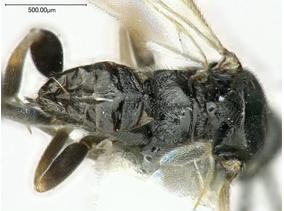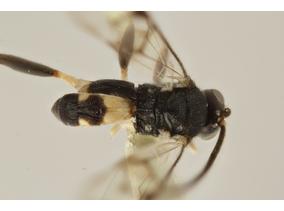You are here
Extant genera and species of Microgastrinae
Diolcogaster Ashmead 1900
Nomenclature
-
Subfamily: Microgastrinae
SUMMARY
The genus Diolcogaster Ashmead is one of the most poorly understood groups in the subfamily Microgastrinae (particularly in the New World), although it is one of the dominant genera of the subfamily. Members of this genus are among the most important endoparasitoids of Lepidoptera, and most of them feed gregariously on macrolepidopterans, such as Arctiidae, Geometridae, Noctuidae, and Notodontidae. It is easily distinguished from other genera within Microgastrinae in spite of its morphologically diverse species composition, but diagnostic key characters for Diolcogaster appear not to be uniquely derived. Therefore, it is divided into many distinct species groups, some of which appear to have closer relationships with other genera.
The genus Diolcogaster was first proposed by Ashmead (1900) based on the previously known species Microgaster brevicaudus Provancher (1886), but Ashmead did not provide any formal description. Several taxonomists, therefore, followed the previous systems, and described 16 species now contained in Diolcogaster under other generic names (mostly in the genus Microgaster and a few in Apanteles and lchneumon) from around World (Cameron 1904, de Saeger 1944,Gahan 1918, Muesebeck 1922,Viereck 1913, Watanabe 1937 and Wilkinson 1929,1930,1932). Nixon (1965) reclassified a member of confusing and poorly defined genera among the non-Apanteles microgastrine genera at that time, and placed most Diolcogaster species (44) under the genus Protomicroplitis, which he divided into 22 species groups.
Mason (1981) reestablished the genus with a more accurate and detailed redescription based on the type species, Microgoster brevicaudus, and included 17 species groups from Protomicroplitis (sensu Nixon), cornprising 24 species. Tobias (1936) listed 10 Diolcogaster species with five new combinations in his faunal study of the European part of the USSR. More recently, Saeed et al. (1999) revised 26 Australasian species of the genus and estimated that about 200- 300 undescribed species exist worldwide.In the New World, Whitfield (1997) estimated a total of at least 50 -100 Diolcogaster species.
,The genus Diolcogaster Ashmead is one of the most poorly understood groups in the subfamily Microgastrinae (particularly in the New World), although it is one of the dominant genera of the subfamily. Members of this genus are among the most important endoparasitoids of Lepidoptera, and most of them feed gregariously on macrolepidopterans, such as Arctiidae, Geometridae, Noctuidae, and Notodontidae. It is easily distinguished from other genera within Microgastrinae in spite of its morphologically diverse species composition, but diagnostic key characters for Diolcogaster appear not to be uniquely derived. Therefore, it is divided into many distinct species groups, some of which appear to have closer relationships with other genera.
The genus Diolcogaster was first proposed by Ashmead (1900) based on the previously known species Microgaster brevicaudus Provancher (1886), but Ashmead did not provide any formal description. Several taxonomists, therefore, followed the previous systems, and described 16 species now contained in Diolcogaster under other generic names (mostly in the genus Microgaster and a few in Apanteles and lchneumon) from around World (Cameron 1904, de Saeger 1944,Gahan 1918, Muesebeck 1922,Viereck 1913, Watanabe 1937 and Wilkinson 1929,1930,1932). Nixon (1965) reclassified a member of confusing and poorly defined genera among the non-Apanteles microgastrine genera at that time, and placed most Diolcogaster species (44) under the genus Protomicroplitis, which he divided into 22 species groups.
Mason (1981) reestablished the genus with a more accurate and detailed redescription based on the type species, Microgoster brevicaudus, and included 17 species groups from Protomicroplitis (sensu Nixon), cornprising 24 species. Tobias (1936) listed 10 Diolcogaster species with five new combinations in his faunal study of the European part of the USSR. More recently, Saeed et al. (1999) revised 26 Australasian species of the genus and estimated that about 200- 300 undescribed species exist worldwide.In the New World, Whitfield (1997) estimated a total of at least 50 -100 Diolcogaster species.






